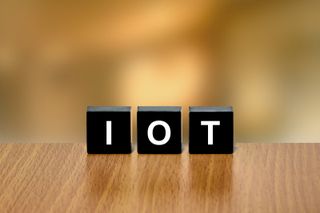Searching for IoT devices that look great? We have the answer
There's no point in getting rid of wires to replace them with something ugly

Reader Josh Evans got in touch recently. He explained how he's a bit of a "neatness freak" (his words, not mine), and how this obsession has caused him issues with home and office automation experiments to date. He went on to explain: "I'm one of those people who likes things to look neat and tidy. I can't stand seeing wires everywhere, and that's one of the reasons why, despite having been interested in the technology for some time, I've only recently started playing with automation products in any serious way. And that's because it's only in the past year or two that wire-free sensors, switches and other devices have become widely available."
For a long time he'd wanted to replace the lock on his studio door (he's an art restorer) with an electronic version, so that he'd be able to let in visitors from his desk. Only recently have insurance-approved Z-Wave locks become available, allowing him to do this neatly and reliably.
Although wireless technology has started to help Josh achieve his dreams, he still has one big problem: "Why does so much of the equipment on the market just look like horrible, unattractive boxes? What's the point of eliminating wires if you're just going to replace them with something equally ugly? Where's the design? My friends and family take the mickey, saying I'm 'a bit OCD', but I see that as a compliment rather than a put-down. Please can you recommend some home automation kit that actually looks nice (or even better, is invisible)? In particular, door and window sensors that don't look like you've glued an old matchbox to the frame."
I think it's perfectly reasonable to have such aesthetic sensibilities, and it certainly shouldn't result in mockery. Josh is right: most home automation devices are just plain ugly! In this Internet of Things (IoT) age we seem to have swapped unsightly wires for unsightly boxes.
So I had a chat with the lovely and always helpful people at Vesternet and asked them to send me a few sensors to have a play with, on the proviso that they needed to be pleasing to the eye. A few days later, Postman Pat turned up with a package of goodies that Vesternet had kindly sent for evaluation.
The first device out of the box is one that I don't think will suit Josh, but let's take a look at it anyway, because it's interesting. It's the Fibaro FGK-10x. It's a conventional two-box door or window sensor. One very small box contains a magnet; the other, larger box contains the battery, wireless electronics, and a way to detect the magnet.
There are three common methods for doing the latter manufacturers can use a reed switch, a Hall effect sensor or an anisotropic magneto-resistive (AMR) sensor. A reed switch is essentially two skinny bits of metal in a tiny glass tube. Under normal circumstances there's a small air-gap between the contacts, but when the switch enters a magnetic field, the two contacts come together and so a circuit is made. It's a simple idea, which was invented in the 1930s, but it works well.
Get the ITPro. daily newsletter
Receive our latest news, industry updates, featured resources and more. Sign up today to receive our FREE report on AI cyber crime & security - newly updated for 2024.
A Hall effect sensor, on the other hand, is a solid-state device where a signal is generated by the magnetic field density around it; and an anisotropic magnetoresistive sensor is a device where the resistance is changed by the magnetic field. Hall and AMR-based sensors can be more sensitive, but require complex supporting electronics. If your tablet or phone is a unit that goes to sleep when a flip cover is shut, it probably uses magnets in the flap and Hall effect or AMR sensors in the device body to sense when it should switch off.
Paul runs a specialist digital agency called CST Group where he helps create websites and web-based tools, specialising in high-end hosting and managed cloud computing. If you've ever booked a meal in a pub or dealt electronically with a solicitor, you may well have used one of his systems.
Paul has also been writing for PC Pro for decades. Not quite issue one, but not far off. He writes about all sorts of tech things including gadgets, the Internet of things, building and hosting websites, single board computers like the Raspberry Pi, home automation, energy efficiency and pretty much anything else he's interested in. One month his column might be monitoring the output of solar panels using IoT kit and the next it could be debugging complex SQL queries in a CRM system.
You can reach him directly at pcpro@ockenden.com or @PaulOckenden





